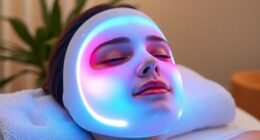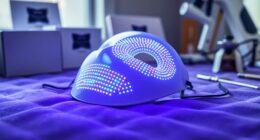LED light therapy masks come with several downsides. There’s limited scientific evidence on their effectiveness, and results can vary widely between users. You might need to invest a lot of time, with sessions lasting up to 30 minutes and requiring consistent use. Additionally, prolonged exposure can pose eye damage risks. The cost of these devices can range dramatically, making them a significant investment. Want to know more about how to navigate these challenges?
Key Takeaways
- Limited scientific evidence questions the effectiveness of at-home LED light therapy masks compared to in-office treatments.
- Inconsistent results can occur due to individual skin types and device quality, leading to varying treatment outcomes.
- Regular use requires a significant time commitment, often 30 minutes to 2.5 hours weekly, which can be challenging for busy individuals.
- Prolonged exposure to certain wavelengths may pose risks of eye damage, necessitating protective eyewear during treatment.
- High costs of LED masks raise concerns about their value compared to professional treatments, which may offer better results.
Limited Scientific Evidence
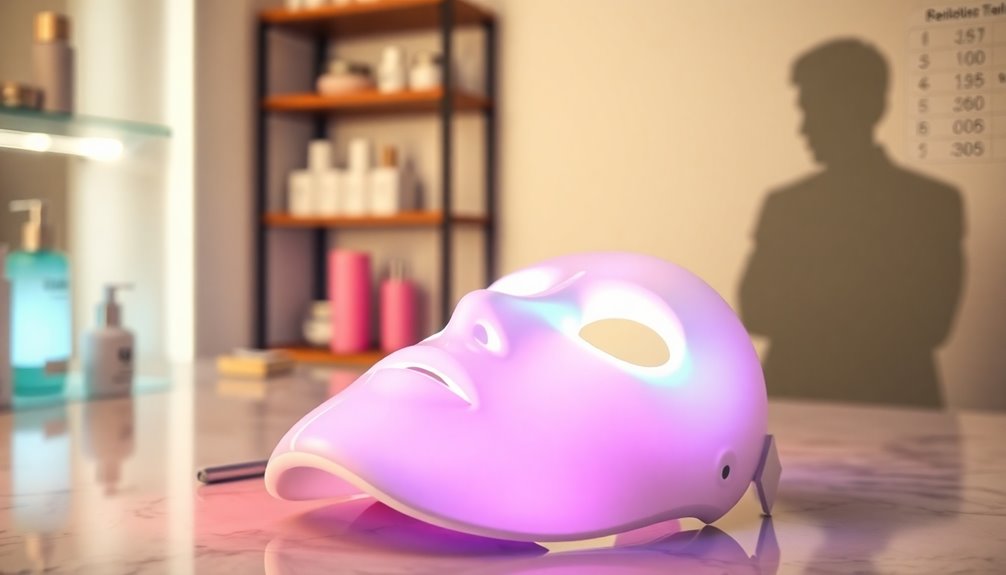
While LED light therapy masks may seem like a promising solution for skin issues, the limited scientific evidence surrounding their effectiveness raises some concerns.
Most clinical studies focus on in-office treatments, which are generally stronger than at-home devices. This leaves uncertainty about the long-term efficacy of these masks.
Additionally, many studies involve small sample sizes and often lack thorough research on various skin types and tones, limiting understanding of their effectiveness across diverse populations.
Although some reports indicate subtle improvements, the scientific community emphasizes the need for larger randomized controlled trials to validate the manufacturer claims.
Until then, the effectiveness of LED masks for different skin conditions remains unproven, making it essential to approach their use with caution.
Inconsistent Results
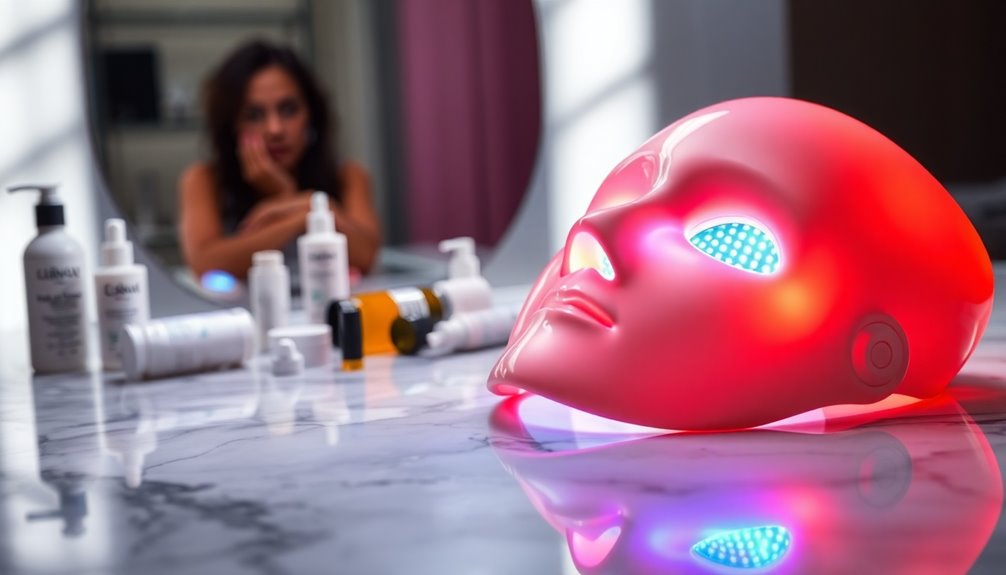
When using LED light therapy masks, you might notice inconsistent results based on your unique skin type and the quality of the device.
While some people experience improvements, others may find little to no change, which can be frustrating.
The differences in how devices emit light can also play a significant role in the effectiveness of your treatment.
Varying Skin Types
As you explore LED light therapy masks, you might notice that their effectiveness can vary greatly based on your skin type. Different individuals respond uniquely to varying wavelengths, which can lead to inconsistent results.
Here are a few factors to take into account:
- Skin Texture: Younger skin might show quicker results, while mature skin often requires more time.
- Skin Condition: Those with hormonal acne or cystic lesions may not benefit as much from blue light therapy targeting acne-causing bacteria.
- Skin Tone: Red light therapy’s effectiveness can diminish in individuals with darker skin tones, highlighting the need for further research.
Your skin care routine also plays an essential role, as certain products can enhance or inhibit the results of LED masks.
Device Quality Differences
The quality of LED light therapy masks can markedly impact your results, which means choosing the right device is essential.
Lower-priced LED face masks often lack the necessary power or precise wavelengths of light needed for ideal efficacy. Unlike professional in-office devices, many at-home options don’t emit the same intensity, leading to longer treatment times or minimal improvements.
Additionally, differences in device quality can cause inconsistent distribution of light, affecting various facial areas unevenly. Some masks may not be FDA approved, raising safety concerns and questioning their efficacy.
Furthermore, varying wavelengths may not effectively target specific skin concerns, resulting in mixed outcomes that mightn’t meet your expectations.
Time Commitment for Regular Use
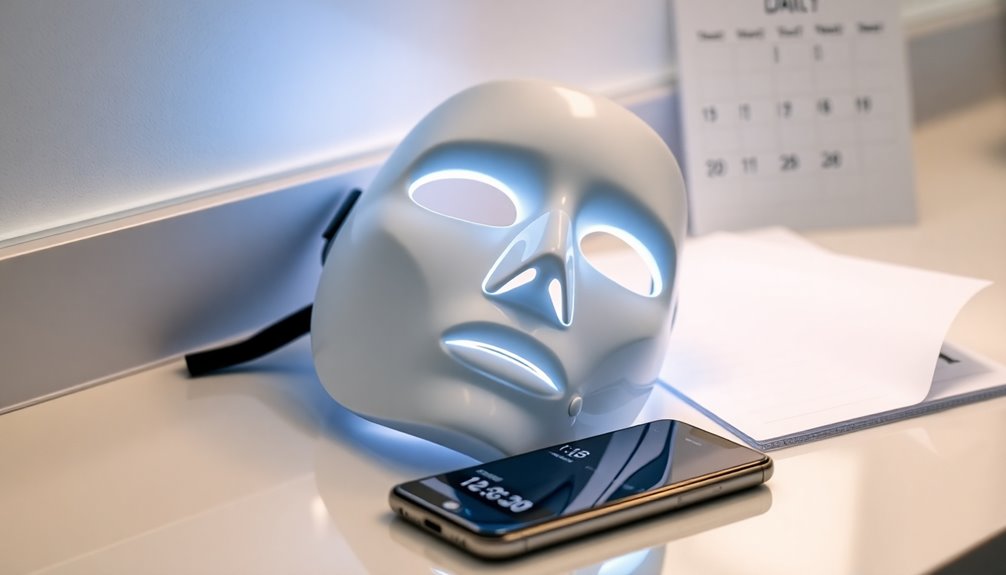
Incorporating LED light therapy masks into your routine can be a significant time commitment, especially since consistent usage is often recommended 3-5 times a week. Each session can last anywhere from 10 to 30 minutes, which adds up quickly.
Here’s what to take into account:
- Overall Time Investment: You may need to allocate 30 minutes to 2.5 hours weekly.
- Scheduling Challenges: Fitting regular treatments into a busy schedule can be tough.
- Cumulative Results: These masks require discipline to see benefits over time, unlike quick fixes.
For those looking for immediate results, the commitment to LED light therapy might lead to frustration, as consistent use is essential for effective skincare.
Potential Eye Damage Risks
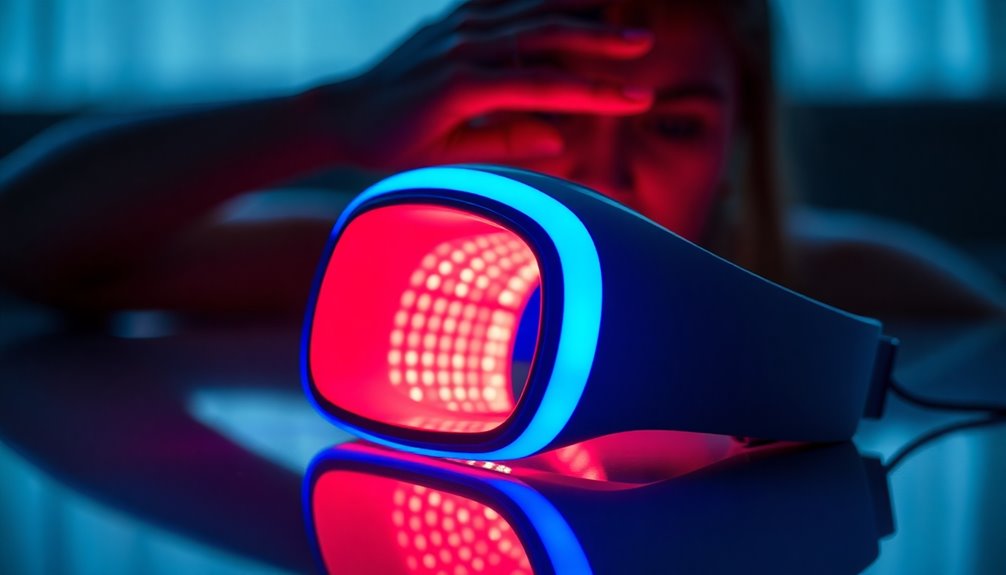
When using LED light therapy masks, you need to be aware of potential eye damage risks.
Prolonged exposure, especially to blue light, can harm your eyes, so following manufacturer safety guidelines is essential.
Always consider using protective goggles to shield your eyes during treatment sessions.
Eye Protection Necessity
How safe are your eyes during LED light therapy sessions? If you’re using an LED light therapy mask, it’s crucial to prioritize eye protection.
Without adequate eye protection, you could face several risks:
- Blurry vision: You may experience temporary visual disturbances after treatment.
- Potential eye injury: Certain wavelengths, especially blue light, can harm your ocular health.
- Exacerbated symptoms: Individuals with pre-existing eye disorders should seek consultation with a healthcare professional before use.
The Neutrogena Light Therapy Acne Mask recall underscores these risks.
Always use goggles or shielding devices to protect your eyes during sessions.
Remember, prioritizing eye health is essential, especially since long-term safety data on LED light therapy is limited.
Stay safe and informed!
Prolonged Exposure Concerns
While you focus on eye protection during LED light therapy sessions, it’s important to contemplate the risks associated with prolonged exposure to these devices.
Extended use, especially with blue light, can lead to eye damage, including blurry vision and eye pain. The recall of the Neutrogena Light Therapy Acne Mask underscores these concerns.
To prevent visual complications, you should utilize eye safety precautions, like wearing blackout goggles. If you have existing eye disorders, consult a healthcare professional before starting treatment, as they may heighten the risks.
Ignoring proper eye protection can result in serious eye issues, so always adhere to safety guidelines when using LED masks to safeguard your vision.
Manufacturer Safety Guidelines
Although using LED light therapy masks can be beneficial for your skin, it’s essential to prioritize safety by adhering to manufacturer guidelines to prevent potential eye damage.
Prolonged exposure to blue light can harm your retina, leading to serious eye injuries. To minimize risks, consider these safety guidelines:
- Always wear protective eyewear: Use blackout or opaque goggles as recommended by manufacturers to shield your eyes during treatment.
- Follow usage times: Stick to the manufacturer recommendations for treatment duration to avoid potential risks and side effects, like blurry vision or eye pain.
- Be cautious if you have pre-existing conditions: If you have any eye-related issues, consult a professional before starting LED therapy.
Prioritizing eye protection guarantees a safer experience with LED masks.
High Cost of Devices
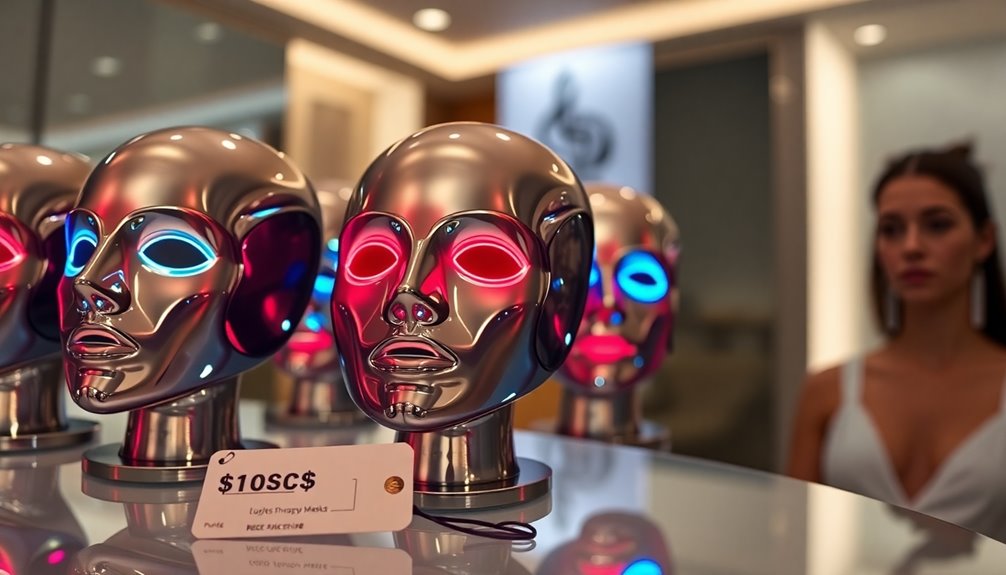
Investing in an LED light therapy mask can set you back anywhere from under $50 to nearly $2,000, making it a considerable financial commitment.
While high-end devices, like the Dr. Dennis Gross LED mask, can offer some benefits, many at-home treatments yield only mild results. This raises questions about whether the high cost justifies the investment, especially when in-office treatments can range from $150 to $300 per session.
If you’re seeking effective skincare solutions, you might find more affordable alternatives that deliver better results without the steep price tag.
Balancing your budget with the desire for effective skincare can be challenging, so it’s essential to weigh the financial commitment against the potential benefits of LED light therapy devices.
Not Suitable for All Skin Types

Not every skin type is a good match for LED light therapy masks, particularly if you have specific conditions like photosensitivity disorders or severe cystic acne. These issues can lead to increased irritation or inflammation.
It’s crucial to assess the following:
- Individuals with active skin infections should avoid LED masks, as they may worsen these conditions.
- Darker skin tones may not have enough research backing the safety and efficacy of LED therapy, raising concerns without dermatologist guidance.
- Those with eye disorders need to be cautious, as extended exposure to certain wavelengths can cause complications.
Due to individual skin sensitivities, you could experience adverse reactions like redness or irritation, highlighting the importance of a personalized assessment before use.
Frequently Asked Questions
Do LED Masks Have Side Effects?
Yes, LED masks can have side effects. You might experience mild skin irritation or increased sensitivity, especially if you use them too much or without proper guidance.
After treatment, some users report temporary redness or rashes. Also, prolonged exposure to certain wavelengths can cause inflammation.
If you have pre-existing skin conditions, it’s best to consult a dermatologist. Always prioritize eye safety and consider using protective eyewear to prevent visual discomfort.
What Does Mayo Clinic Say About Red Light Therapy?
The Mayo Clinic highlights that red light therapy can improve skin conditions like wrinkles and acne by boosting collagen production and reducing inflammation.
They note that while it’s generally safe, you might experience mild side effects such as redness or irritation.
It’s essential for you to use FDA-cleared devices and consult a healthcare professional before starting treatment.
What Are the Negatives of LED Light Therapy?
Did you know that nearly 30% of users experience mild skin irritation with LED light therapy?
While these treatments promise clearer skin, you might encounter downsides like increased photosensitivity, especially after prolonged use.
Eye safety is essential, as certain wavelengths can cause discomfort if you’re not careful.
Plus, at-home masks often require consistent use for minimal results, and their high prices may not justify the benefits for everyone.
Always weigh the risks and rewards before diving in.
Who Shouldn’t Use a LED Face Mask?
If you have light sensitivity or specific eye disorders, you shouldn’t use an LED face mask, as it could worsen your symptoms.
Avoid these masks if you’re taking photosensitizing medications since they can heighten sensitivity to light.
Individuals with active skin conditions like eczema or severe rosacea may experience more irritation.
If you’re pregnant or nursing, it’s best to consult a doctor before using one.
Finally, those with a history of skin cancer should seek medical advice first.
Conclusion
In the world of skincare, LED light therapy masks might seem like a miracle fix, but don’t let the glow blind you to their downsides. With limited scientific backing and inconsistent results, it’s essential to weigh the time, cost, and potential risks involved. After all, isn’t it better to choose a treatment that truly suits your skin type? Before diving in, consider whether this trend really fits your personal skincare journey.







